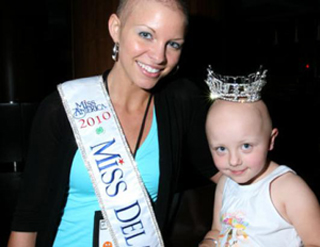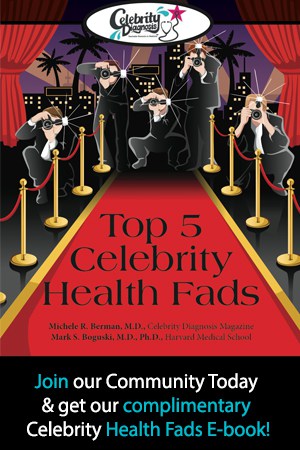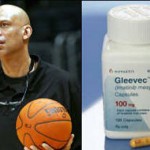Miss America Pageant Includes Bald Beauty

This year’s Miss America Pageant has one contestant that epitomizes the phrase “Bald is Beautiful.” Miss Delaware, Kayla Martell, isn’t afraid to talk about her lack of hair. In fact, she is looking forward to the opportunity to educate the public about the condition that has left her bald- alopecia areata. Kayla began losing her hair at the age of 10. Although she usually goes wig-free, she will be donning a long blond wig in the competition, which airs tonight.
What is Alopecia Areata? (Source: National Institute of Arthritis and Musculoskeletal and Skin Conditions)
Alopecia areata is considered an autoimmune disease, in which the immune system, which is designed to protect the body from foreign invaders such as viruses and bacteria, mistakenly attacks the hair follicles, the tiny cup-shaped structures from which hairs grow. This can lead to hair loss on the scalp and elsewhere. In most cases, hair falls out in small, round patches about the size of a quarter. For many the disease does not extend beyond a few bare patches, although in some people, hair loss is more extensive. Although uncommon, the disease can progress to cause total loss of hair on the head (referred to as alopecia areata totalis) or complete loss of hair on the head, face, and body (alopecia areata universalis).
In alopecia areata, immune system cells called white blood cells attack the rapidly growing cells in the hair follicles that make the hair. The affected hair follicles become small and drastically slow down hair production. Fortunately, the stem cells that continuously supply the follicle with new cells do not seem to be targeted. So the follicle always has the potential to regrow hair.
Scientists do not know exactly why the hair follicles undergo these changes, but they suspect that a combination of genes may predispose some people to the disease. In those who are genetically susceptible, some type of trigger – perhaps a virus or something in the person’s environment – brings on the attack against the hair follicles.
Alopecia areata is not a life-threatening disease. It does not cause any physical pain, and people with the condition are generally healthy otherwise. But for most people, a disease that unpredictably affects their appearance the way alopecia areata does is a serious matter, with effects being primarily social and emotional.
The course of the disease varies from person to person. For many, hair will regrow, but it may also fall out again. Some people lose just a few patches of hair, then the hair regrows, and the condition never recurs. Other people continue to lose and regrow hair for many years. Even in those who lose all their hair, the possibility for full regrowth remains.
How Is It Treated?
Although there is neither a cure for alopecia areata nor drugs approved for its treatment, some people find that medications approved for other purposes can help hair grow back, at least temporarily. Keep in mind that although these treatments may promote hair growth, none of them prevent new patches or actually cure the underlying disease. Consult your health care professional about the best option for you.
Corticosteroids – Corticosteroids are powerful anti-inflammatory drugs similar to a hormone called cortisol, which is produced in the body. Because these drugs suppress the immune system if given orally, they are often used in the treatment of various autoimmune diseases, including alopecia areata. Corticosteroids may be administered in three ways for alopecia areata:
- Local injections – Injections of steroids directly into hairless patches on the scalp and sometimes the brow and beard areas are effective in increasing hair growth in most people. It usually takes about 4 weeks for new hair growth to become visible. Injections deliver small amounts of cortisone to affected areas, avoiding the more serious side effects encountered with long-term oral use. The main side effects of injections are transient pain, mild swelling, and sometimes changes in pigmentation, as well as small indentations in the skin that go away when injections are stopped. Large areas cannot be treated, however, because the discomfort and the amount of medicine become too great and can result in side effects similar to those of the oral regimen.
- Oral corticosteroids – Corticosteroids taken by mouth are a mainstay of treatment for many autoimmune diseases and may be used in more extensive alopecia areata. But because of the risk of side effects of oral corticosteroids, such as hypertension and cataracts, they are used only occasionally for alopecia areata and for shorter periods of time.
- Topical ointments – Ointments or creams containing steroids rubbed directly onto the affected area are less traumatic than injections and, therefore, are sometimes preferred for children. However, corticosteroid ointments and creams alone are less effective than injections; they work best when combined with other topical treatments, such as minoxidil or anthralin.
Minoxidil (5 percent) (Trade name: Rogaine) – Topical minoxidil solution promotes hair growth in several conditions in which the hair follicle is small and not growing to its full potential. Minoxidil is FDA-approved for treating male and female pattern hair loss. It may also be useful in promoting hair growth in alopecia areata. The solution, applied twice daily, has been shown to promote hair growth in both adults and children, and may be used on the scalp, brow, and beard areas. With regular and proper use of the solution, new hair growth appears in about 12 weeks.
Anthralin – Anthralin, a synthetic tar-like substance that alters immune function in the affected skin, is an approved treatment for psoriasis. Anthralin is also commonly used to treat alopecia areata. Anthralin is applied for 20 to 60 minutes (“short contact therapy”) to avoid skin irritation, which is not needed for the drug to work. When it works, new hair growth is usually evident in 8 to 12 weeks. Anthralin is often used in combination with other treatments, such as corticosteroid injections or minoxidil, for improved results.
























0 comments